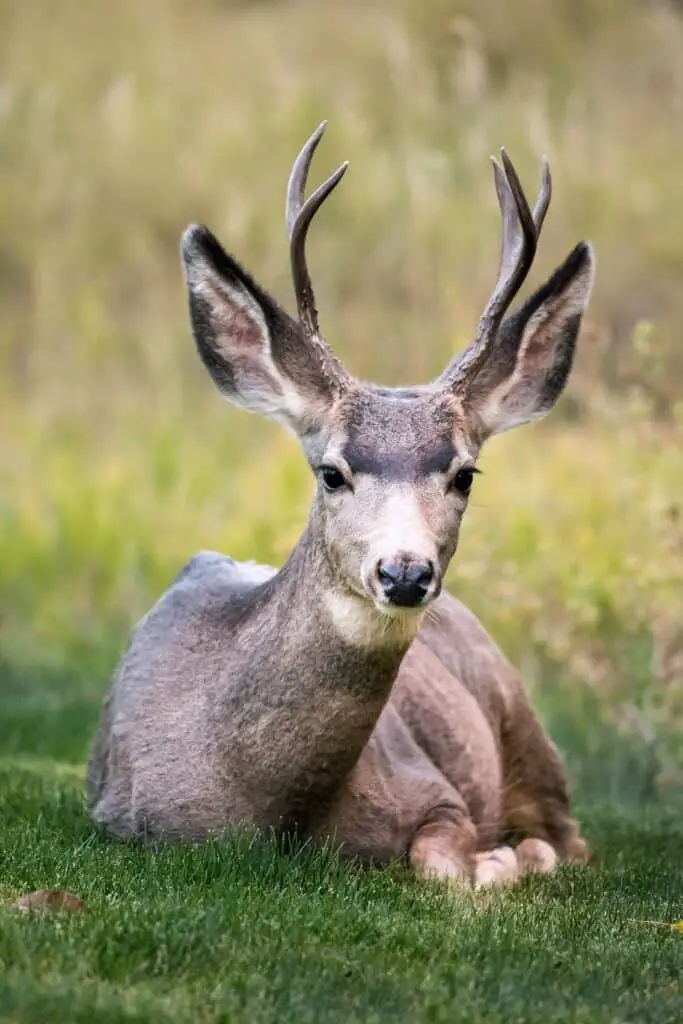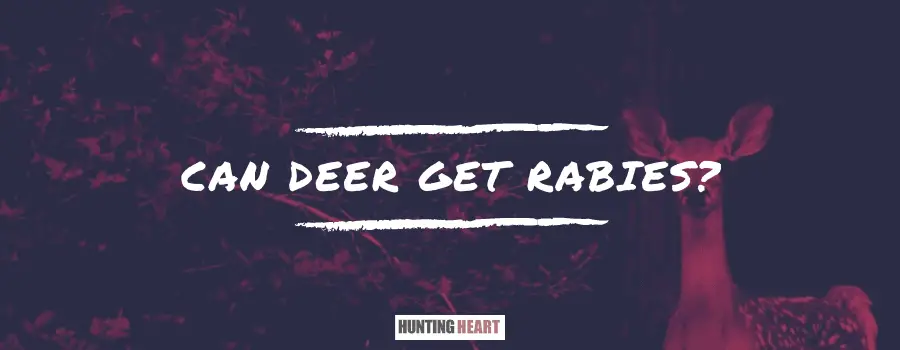As an Amazon Associate I earn from qualifying purchases.
Our Associate portal can be found here
You’ll often hear of rabid dogs, bats, skunks, foxes, and raccoons; but rarely would you suspect your season harvest targets to be affected by the deadly disease. However, several cases around the country have, without a doubt answering the question, ‘can deer get rabies?’
Rabies is highly contagious and can affect all mammals. It causes the swelling of the brain, and is fatal if left untreated. Although rabid deer are rare, symptoms include loss of balance, lethargy, orifice discharge, and aggressiveness. Loss of fur on the head or alopecia is the definitive sign that an ungulate is infected.
Rhabdovirus of the Rhabdoviridae family is the nasty microbe that causes rabies, attacking the nervous system of mammals. Once the clinical signs are confirmed, this contagion is almost always deadly. Let’s dig in and find out for sure if and how deer can get rabies.
What Is Rabies, and Can Deer Get It?
The name rabies comes from Latin ‘to rage’, which fits how the victim hyperventilates, thrashes, and is aggressive. Another form of the disease has less sensational death throes. Characteristics include numbness, depression, apathy, coma, or paralysis. After the initial symptoms, the viral ailment is incurable, proving 100% fatal.

Rabies is a devastatingly terrifying disease, a contagious viral infection affecting all mammalian or warm-blooded species. Be very careful whenever you contact a rabid animal. After infection, the disease can cause death within a short period without the proper medication. Rabies is more prevalent in smaller animals such as raccoons, feral cats, bats, skunks, foxes, and coyotes.
On average, seven to ten thousand animals contract rabies every year. But experts believe many cases aren’t identified before they die. Deer and humans catch rabies by coming into contact with the saliva or tissue of an infected animal. Raccoons have the highest disease incidences, almost half the national average. Varmint that gets infected possibly got bitten by that rabid critter.
How Is Rabies Transmitted, and How Can Deer Get It?
In the early 2000s till 2018, Mid-Atlantic state’s hunting grounds experienced a rabid raccoon epidemic. It drove this critter’s share of the national average close to 90%. Rabies is transmitted from one mammal to another, primarily through saliva. An array of infected animals started showing up across the range due to bites, including beavers, bears, and whitetail bucks.
Rabies microbes aren’t transmitted by blood, feces, or urine of an infected animal, and they don’t go airborne either. Deer will probably lick the bite wound from a raccoon and its salivary glands; the virus will pass into the brain and neurological system. This strain of the virus acts ten times faster than other types. It’s best to give deer that’s acting symptomatic a wide berth.
The last stage of the disease involves shedding or passing the contagion from the brain back to the saliva of the infected deer. The virus paralyzes internal throat muscles, leading the animal to froth and foam gobs the liquid as they attempt to harass and attack anything in their way.
During this period, rabies is highly contagious but can only transmit through the animal’s bite, saliva, or nervous system tissue. Paralysis follows a few days before the animal’s death.
What Are the Signs of Rabies in Deer?
Symptoms of progressed rabies are salivation, excessive aggression, and restlessness. It makes it easier to spread the infection during its last stage. Rabid deer will act agitated, excessive drooling while snapping and biting at real or imaginary subjects. There’ll also be discharging heavily from their eyes and nose.

Deer with a rabies infection may appear timid or tame and unafraid of humans, but they’ll also be wobbling around and circling disorientated. While these are suspect signs, they could also be indicative of CWD or lead poisoning. So what are the telltale behavioral symptoms of rabies alone?
Although not strictly descriptive of deer, rabies will make a nocturnal animal such as a skunk, raccoon, or bat come out during the day. Deer that rarely venture into populated areas will loiter around the neighborhood seeking someone or something to attack. A usually timid Bambi that becomes actively aggressive while exhibiting drool and self-mutilation, coupled with alopecia or bare-headedness, is rabid.
Can You Catch the Rabies Virus from an Infected Deer?
Thankfully, human rabies cases have decreased in the US, and there’s an average of one or two each year. While this number is far less than people struck by lightning, take utmost precaution for you and your pet’s or livestock’s protection. Avoid any deer you’ll come across that looks sick, and know that symptoms for Chronic Wasting Disease or CWD and rabies are almost similar.
If you accidentally get exposed, find qualified medical help immediately while avoiding contact with others or your pets. To better protect yourself, your dogs, and cats, keep them vaccinated. Key facts to keep in mind about the disease include;
- The rabies virus is transmitted to the deer’s saliva glands from where it’s passed into the brain and vice versa during its last stage.
- Transmission is through the saliva, bite, or contact with an infected animal’s carcass, especially neurological system tissue.
- The virus isn’t airborne and can’t pass through unbroken skin unless abrasions, scratches, or open wounds.
- The virus that causes rabies is short-lived when exposed to air, only surviving in an infected animal’s saliva until it dries up. Avoid places that have been frothed on and disinfect the coats of pets who’ve come in contact with rabid deer.
- Use protective hand gloves when handling any saliva or carcass of deer you suspect has rabies. Many states will allow the killing of rabid deer even out of hunting range or season.
What To Do When Hunting in an Area Where Deer are Susceptible to Rabies
In deer, it’s easy to confuse the symptoms of rabies with other neurological diseases such as Chronic Wasting Disease and Hemorrhagic Disease or HD. These ailments make angulates have abnormal behavior such as having no fear of humans and disinterest with grazing or other social functions. HD is, however, characterized by swollen eyelids, tongue, and neck or head, while CWD presents with severe weight loss.
It’s vital that, as a hunter, you never consume venison from a diseased animal. Not only should you know how to identify and differentiate these deadly diseases, but it’s also essential you contact your local game and fish department immediately if you see a sick ungulate. Remember that there’s pre-symptomatic rabies, so even when your harvest appears to be healthy, handle it with latex gloves, especially before and during field dressing.
When boning out your venison, remove the fat, connective tissue, and lymph nodes, after which you should wash hands and instruments thoroughly. Avoid the spine, brain, spleen, eyes, lymph nodes, and tonsils of your harvest, as this is where the rabies virus establishes itself. You shouldn’t mix commercially processed meat with other hunters’ meat or animal carcasses.
Conclusion
If you are heading this hunting season outdoors, be on the lookout for deer behaving rapidly and avoid contact with other animals showing symptoms. Cook all meat correctly at the right temperatures and cooking times. Avoid consuming any part of deer raw, and if you think there’s a chance it could have been rabid, don’t touch the venison.
You can make a homemade disinfectant against the rabies virus consisting of half and half water and chlorine bleach. Check your state’s game and fish website for any regulations, rules, or reports of the rabies disease in the area you’re targeting deer before you head out into the field.
Amazon and the Amazon logo are trademarks of Amazon.com, Inc, or its affiliates.

36 years old, been hunting and fishing my entire life – love the outdoors, family, and all kinds of hunting and fishing! I have spent thousands of hours hunting hogs and training hunting dogs, but I’m always learning new stuff and really happy to be sharing them with you! hit me up with an email in the contact form if you have any questions.



